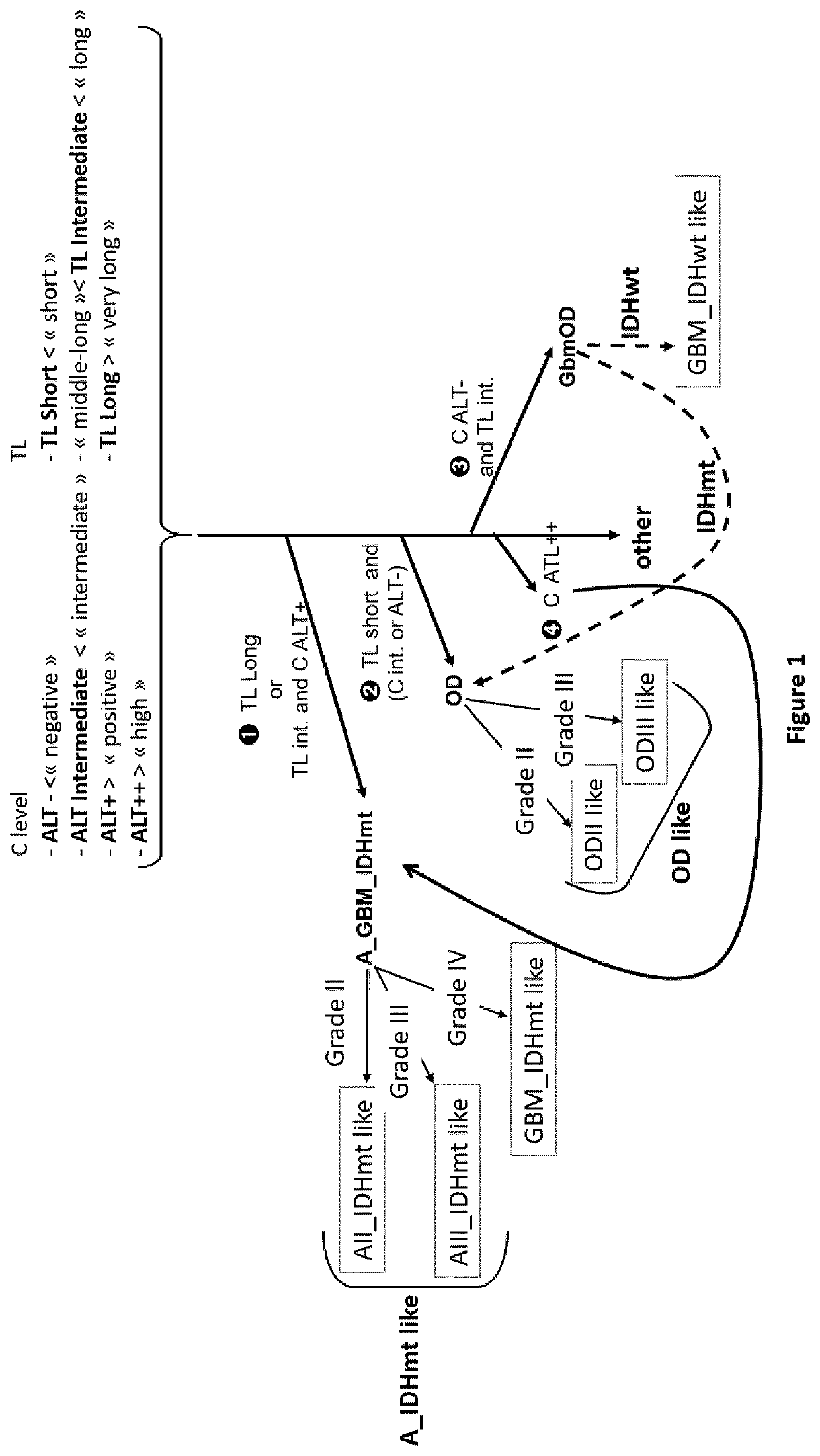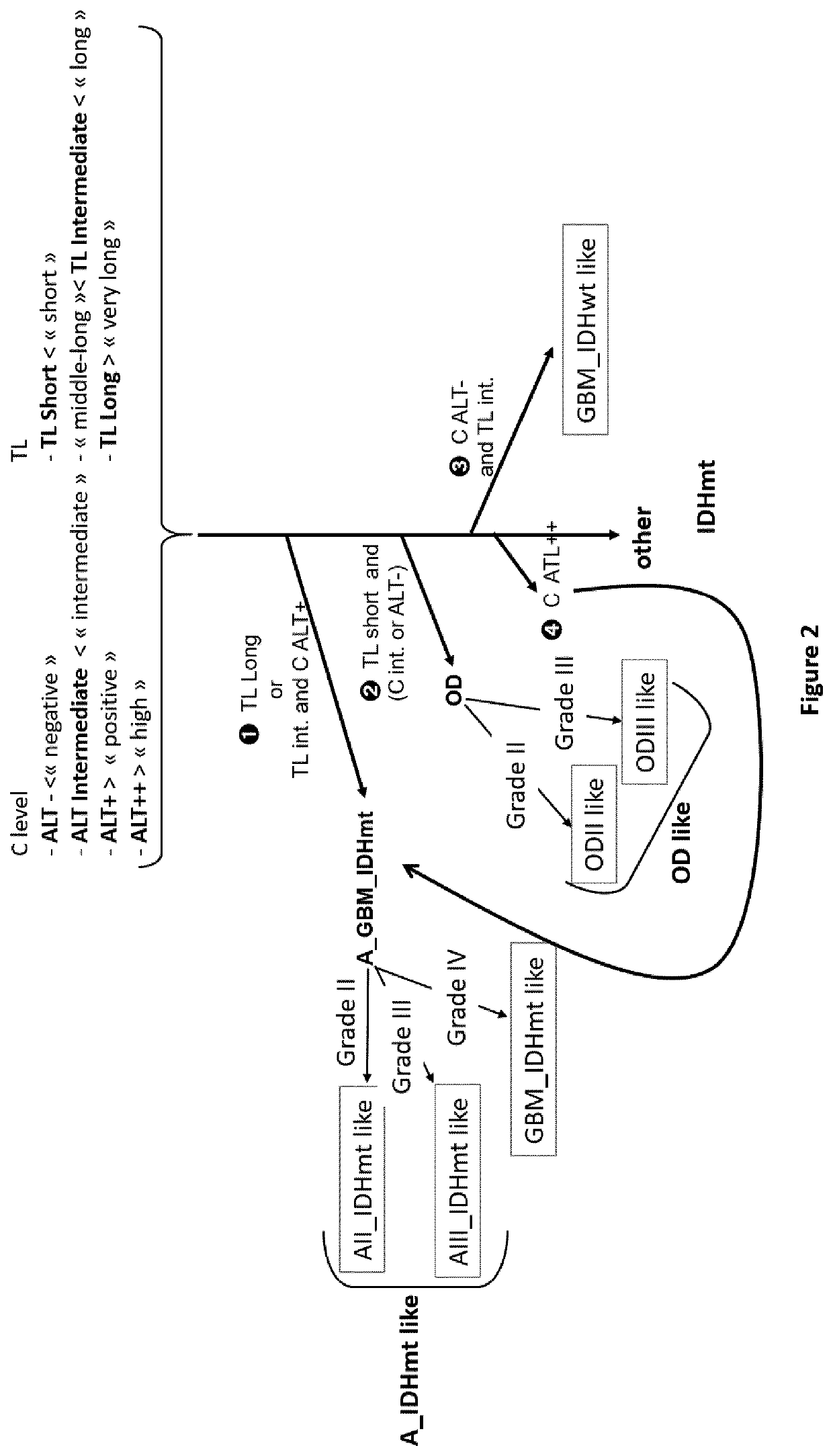Process for classification of glioma
a glioma and brain technology, applied in the field of tumor brain classification, can solve the problems of inability to complete surgical removal, high variability of interpretation, and inability to completely resected ii to iv gliomas, so as to reduce the number of subgroups and achieve the same prognosis significance.
- Summary
- Abstract
- Description
- Claims
- Application Information
AI Technical Summary
Benefits of technology
Problems solved by technology
Method used
Image
Examples
example 1
Reaction
[0354]Rolling circle amplification of C-circle is performed as described in (Henson et al., 2009) and (Henson et al., 2014). Briefly, 3.2 μl of total genomic DNA (5 ng / μL) were incubated for 18 h at 30° C. with 3.75 units of φ29 DNA polymerase (New England Biolabs) (0.375 μL of 10 U / μL), in 0.2 μg / μL of BSA, 0.1% Tween, 4 μM DTT (Dithiothreitol), 1 mM dNTP, 1 μL of 10×NEB buffer. Enzyme is heat-inactivated at 65° C. for 20 min. The same reaction is performed without the enzyme φ29 (φ−).
[0355]For each experiment, two internal controls are added, namely TA and ALT. TA and ALT correspond to total genomic DNA extracted from HeLa (ALT−) and U2OS (ALT+) cell lines respectively.
[0356]The 10 μL of φ− and φ+ reactions are then diluted by adding 30 μL of water (molecular biology grade), 5 μL are used to performed each qPCR reaction.
example 2
riment
[0357]TeloPCR
[0358]Oligonucleotides for the qPCR reaction have been previously described in (Gil et al., 2004) and (Lau et al., 2013) and are listed below
[0359]The sequence for oligonucleotides used in the qPCR are presented in table 2:
SEQ ID5′-CGGTTTGTTTGGforwardNO: 3GTTTGGGTTTGGGTTTel1aTGGGTTTGGGTT-3′SEQ ID5′-GGCTTGCCTTACreverseNO: 4CCTTACCCTTACCCTprimerTACCCTTACCCT-3′tel2BSEQ ID5′-CAGCAAGTGGGARPL0 / 36B4NO: 5AGGTGTAATCC-3′forwardprimerSEQ ID5′-CCATTCTATCATRPL0 / 36B4NO: 6CAACGGGTACAA-3′reverseprimer
[0360]Telo-PCR and qPCR against 36B4 are run in duplicate for each condition φ− and φ+, on a 480 Light Cycler Thermocycler (Roche, Houwald, Luxembourg), in 1× final LightCycler® DNA Master SYBR Green I (10 μL), 200 nM final of TeloPCR-specific primers or 300 nMm final of 36B4-specific primers. Details of thermocycling conditions are detailed below
[0361]For each qPCR, the exact conditions are summarized in tables 3 and 4 below:
TABLE 3TeloPCRAnalysis ModeCyclesSegmentTarget Température...
example 3
ysis, Normalization and Classification
[0366]The fluorescence in logarithmic scale is analyzed as a function of PCR cycle, the threshold is determined by the second derivative method (all experiments). Intersection between the threshold of amplification curve gives the CT for each reaction. The fluorescence channel corresponding to the TeloPCR is the following: SYBR Green (465-510). For the dTeloPCR, two channels are analyzed: SYBR Green (465-510) for the telomeric sequence and CY5 (618-660) for RPLP0 / 36B4.
[0367]Efficiency of TeloPCR (Etelo) and 36B4 (E36B4) PCR are respectively 1.70111 and 1.9672.
[0368]For each reaction, the following value is calculated: Etelo−CT / E36B4−CT, and annotated as φ+ and φ− as a function of the initial circle reaction.
[0369]φ− correspond to the telomere length (T-Length)
[0370]Cr correspond to the Circle score and is calculated as follow: φ+ / φ−
[0371]The difference of T-Length between the two internal controls (U2OS and HeLa) A is calculated and correspond ...
PUM
| Property | Measurement | Unit |
|---|---|---|
| Time | aaaaa | aaaaa |
| Length | aaaaa | aaaaa |
Abstract
Description
Claims
Application Information
 Login to View More
Login to View More - R&D
- Intellectual Property
- Life Sciences
- Materials
- Tech Scout
- Unparalleled Data Quality
- Higher Quality Content
- 60% Fewer Hallucinations
Browse by: Latest US Patents, China's latest patents, Technical Efficacy Thesaurus, Application Domain, Technology Topic, Popular Technical Reports.
© 2025 PatSnap. All rights reserved.Legal|Privacy policy|Modern Slavery Act Transparency Statement|Sitemap|About US| Contact US: help@patsnap.com



